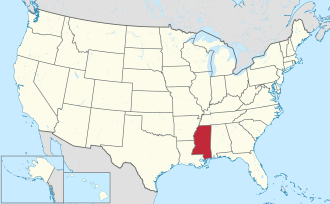Tate County | |
|---|---|
 Tate County Courthouse in Senatobia | |
 Location within the U.S. state of Mississippi | |
 Mississippi's location within the U.S. | |
| Coordinates: 34°39′N89°56′W / 34.65°N 89.94°W | |
| Country | |
| State | |
| Founded | 1873 |
| Seat | Senatobia |
| Largest city | Senatobia |
| Area | |
• Total | 411 sq mi (1,060 km2) |
| • Land | 405 sq mi (1,050 km2) |
| • Water | 6.2 sq mi (16 km2) 1.5% |
| Population (2020) | |
• Total | 28,064 |
| • Density | 68/sq mi (26/km2) |
| Time zone | UTC−6 (Central) |
| • Summer (DST) | UTC−5 (CDT) |
| Congressional district | 1st |
| Website | www |
Tate County is a county located in the northwestern portion of the U.S. state of Mississippi. As of the 2020 census, the population was 28,064. [1] Its county seat is Senatobia. [2] Organized in 1873 during the Reconstruction era, from portions of DeSoto, Marshall, and Tunica counties, the county is named for Thomas Simpson Tate, one of the first prominent American settlers of the area.
Contents
- History
- Geography
- Major highways
- Adjacent counties
- Demographics
- 2020 census
- 2000 census
- Communities
- City
- Town
- Census-designated places
- Unincorporated communities
- Education
- Politics
- Notable people
- See also
- References
- External links
Tate County is part of the Memphis, TN-MS-AR Metropolitan Statistical Area. It is located about 40 miles (64 km) south of Memphis and one county east of the Mississippi River. This fertile river valley was developed for cotton cultivation in the 19th century.









